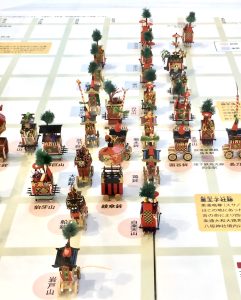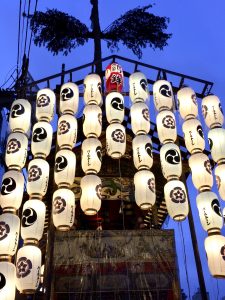動く美術館、祇園祭(愛知県名古屋市千種区 骨董買取 古美術風光舎)
2023.07.01
皆さまこんにちは。スタッフHでございます。
最近は傘が役に立たないほどの土砂降りに突然見舞われることが多く、晴れていても安心できませんね。
さて今日7月1日は、京都の夏の風物詩である祇園祭が始まります。
7月中旬の宵山や山鉾巡行が有名ですが、様々な行事が7月1日から始まります。
明日2日には「くじ取り式」で今年の山鉾巡行の順番が決められます。
ただ先頭は「長刀鉾(なぎなたほこ)」と決められており、稚児による「しめ縄切り」は祇園祭のハイライトとも言えます。
先頭を行く高さ25mの長刀鉾が四条麩屋町にさしかかった所で、通りを横切って張られたしめ縄を稚児が刀で切り払い、神域に入る道を開きます。
四条室町を中心に形や大きさも様々で個性豊かな山鉾が町ごとに建てられ、現在は鉾、曳山、舁山(かきやま)、船鉾、傘鉾の五種類の形態があります。
数年前に京都駅に展示されていた山鉾のミニチュアです。
ミニチュア好きにはたまりません。

もとは疫病の流行により朝廷が863年、神泉苑で初の御霊会(ごりょうえ)を行ったことが起源とされています。
御霊会は疫神や死者の怨霊などを鎮めなだめるために行う祭りでした。

それぞれの山鉾には絢爛豪華なタペストリーが飾られています。
西陣織などの日本の織物はもちろん中国やインド、西洋の織物もたくさん見られ、まさに動く美術館と言われる所以です。

現在では技術が消滅してしまい、世界中で祇園祭の山鉾でしか見ることのできない物もあるそうです。
長刀鉾の茶色の梅樹のついたタペストリーは手触りがごわごわした毛で織られ、DNA鑑定でチベットのカモシカの毛の可能性が高いという結果が出たとか。
ところで何故こんなにも国際色豊かなタペストリーが祇園祭の山鉾に飾られているのでしょうか?
調べましたところ、江戸時代、京都の豪商が徳川家に200億円近くのお金を貸し付けていたことがあり、その見返りとして外国から徳川家に贈られたタペストリーを譲られたとのこと。
なんだか徳川家にとって都合のいい話に聞こえますが、当時の豪商たちはその高価なタペストリーを惜しげもなく民衆に披露し、祇園祭を盛り上げたとのことです。
遥か遠い昔、遠い国からやってきた絢爛豪華な美術品を目の前で堪能できる貴重なお祭りとも言えますね。
コンチキチンと甲高く響く「鉦(かね)」の音で知られる「祇園囃子(ばやし)」。
すべての山鉾がお囃子を演奏するわけではなく、34ある山鉾のうち14の山鉾だけが演奏し、それぞれの山鉾によって音色が違うとか。知りませんでした…。
いずれにせよ聞くだけで夏を感じることの音色です。

それでは、またお会いしましょう。
Hello everyone. This is Staff H.
Recently, we are often suddenly hit by downpours so heavy that umbrellas are useless, so even if the weather is fine, we cannot feel safe.
Today, July 1, marks the beginning of the Gion Festival, a summer tradition in Kyoto.
While Yoiyama and Yamaboko Junko (float procession) in mid-July are the most famous events, various other events also start on July 1.
Tomorrow, on July 2, the order of this year’s Yamaboko procession will be decided at a “kuji-tori” ceremony.
The first float in the procession will be the Naginataboko, and the “shimenawa-kiri (cutting of the sacred rope)” performed by children is one of the highlights of the Gion Festival.
When the 25-meter-high naginata-hoko, which leads the procession, approaches Shijo Fuyamachi, children use swords to cut off the sacred rope stretched across the street, opening the way for the floats to enter the Shinto shrine.
Each town builds its own unique floats of various shapes and sizes around the Shijo Muromachi area.
Currently, there are five types of floats: hoko, hikiyama, kakuyama, funaboko, and kasaboko.
This is a miniature of a yamahoko that was displayed at Kyoto Station a few years ago.
It is a must-see for miniature lovers.
The origin of the festival is said to date back to 863, when the Imperial Court held the first Goryoe (a ceremony for the spirits of the dead) in Shinsen-en Garden due to the outbreak of an epidemic.
Goryoe was a festival held to appease the gods of plague and the vengeful spirits of the dead.
Each float is decorated with a gorgeous tapestry.
The festival is said to be a “moving art museum” because of the large number of Chinese, Indian, and Western textiles as well as Japanese textiles such as Nishijin brocade.
Some of these techniques have disappeared and can only be seen on the floats of the Gion Festival.
The brown plum-tree tapestry of the naginohoko floats is woven with stiff hair to the touch, and DNA analysis has shown that the hair is most likely that of a Tibetan antelope.
Why, by the way, is such an international tapestry displayed on the floats of the Gion Festival?
According to my research, a wealthy merchant in Kyoto once loaned the Tokugawa family nearly 20 billion yen during the Edo period, and in return, he was given tapestries presented to the Tokugawa family from abroad.
Although this story sounds somewhat convenient for the Tokugawa family, the wealthy merchants of the time generously showed off their expensive tapestries to the public and enlivened the Gion Festival.
It can be said that this festival is a rare opportunity to enjoy in front of one’s eyes the gorgeous and gorgeous works of art that came from a faraway country in the distant past.
The Gion festival is also known for its “Gion-bayashi,” or Gion music, with its high-pitched “kane” (gong) sound.
Of the 34 floats, only 14 play the music, and the tone of the music differs from float to float. The tone of the music differs from float to float. I did not know that.
In any case, you can feel the summer just by listening to the sound.
Well, I will see you again.
*******************
ご実家の整理やお片付けなどをされている方のご相談などが多くございます。
お片付けなどくれぐれもご無理のないようになさってくださいませ。
風光舎では古美術品や骨董品の他にも絵画や宝石、趣味のお品など様々なジャンルのものを買受しております。
お片付けをされていて、こういうものでもいいのかしらと迷われているものでも、どうぞお気軽にご相談下さいませ。
また風光舎は、出張買取も強化しております。ご近所はもちろん、愛知県内、岐阜県、三重県その他の県へも出張いたします。
まずは、お電話お待ちしております。
愛知県名古屋市千種区姫池通
骨董 買取【古美術 風光舎 名古屋店】
TEL052(734)8444
10:00-17:00 OPEN
#出張買取#骨董#古美術#骨董品#絵画#版画#茶道具#刀剣#彫刻

